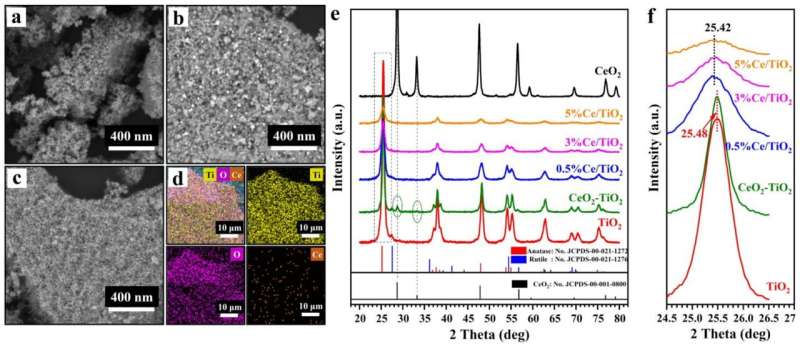This article has been reviewed according to Science X's editorial process and policies. Editors have highlighted the following attributes while ensuring the content's credibility:
fact-checked
trusted source
proofread
Visible light absorption of titanium dioxide achieved through cerium synchronous doping in anatase

The introduction of rare earth elements into TiO2 can effectively improve the electron-hole separation of TiO2 and prolong the visible light response of TiO2.
Cerium (Ce) shows variable valence states Ce3+/Ce4+ with different electronic structures (4f15d0 and 4f05d0, respectively) among rare earth elements, which easily form oxygen vacancies. Ce element with unique electronic structure can be used to modify semiconductor photocatalysts to improve their photocatalytic performance.
In a study published in Molecules, the research group led by Prof. Lu Canzhong from Fujian Institute of Research on the Structure of Matter of the Chinese Academy of Sciences, reported the visible light absorption of Ce/TiO2.
The researchers achieved simultaneous doping of Ce in the TiO2 lattice using a simple sol-gel method which achieved Ce synchronous doping in the lattice of TiO2. They observed morphology and structure of the pure TiO2, Ce-doped TiO2 (Ce/TiO2), and CeO2-mixed TiO2 (CeO2-TiO2) samples by X-ray diffraction (XRD), scanning electron microscopy (SEM), and transmission electron microscopy (TEM). They found that Ce doping in the lattice of anatase TiO2 resulted in a smaller grain size of the sample.
Additionally, the researchers revealed the high photocurrent density (10.9 μA×cm-2) of Ce/TiO2 by linear sweep voltammetry (LSV) test, which is 2.5 times that of common TiO2 material (4.3 μA×cm-2). They evaluated the light absorption range of Ce/TiO2 using incident photo-to-current efficiency (IPCE) test. Ce/TiO2 shows visible light absorption up to 500 nm, while pure TiO2 shows no obvious response in the visible region.
Moreover, the researchers unveiled that the electron-trapping centers formed by Ce doping into the TiO2 lattice improved the separation efficiency of photogenerated electrons and holes. The narrow bandgap of Ce-doped TiO2 showed excellent visible light absorption and photocurrent response. Due to the Ce doping, the Ce/TiO2 samples achieved high photocurrent density and incident photon current efficiency (IPCE).
This study provides a practical strategy and an important reference for the preparation and understanding of highly efficient visible light-activated rare earth-doped photocatalysts.
More information: Mei-Hong Tong et al, Cerium Synchronous Doping in Anatase for Enhanced Photocatalytic Hydrogen Production from Ethanol-Water Mixtures, Molecules (2023). DOI: 10.3390/molecules28062433
Provided by Chinese Academy of Sciences





















